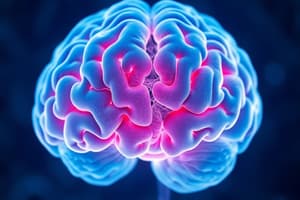Podcast
Questions and Answers
What is the term for the brain's lifelong capacity to learn based on new experiences?
What is the term for the brain's lifelong capacity to learn based on new experiences?
- Cortical representation
- Adaptive plasticity
- Maladaptive plasticity
- Neuroplasticity (correct)
Maladaptive plasticity refers to a brain's improved ability to perform tasks.
Maladaptive plasticity refers to a brain's improved ability to perform tasks.
False (B)
Name one factor that influences neuroplasticity.
Name one factor that influences neuroplasticity.
Repetition and intensity or time sensitivity or task-importance or environment features or patient characteristics or pharmacology.
Neuroplasticity is more amenable early following _____ .
Neuroplasticity is more amenable early following _____ .
Match the following factors with their influence on neuroplasticity:
Match the following factors with their influence on neuroplasticity:
What effect does stress have on neuroplasticity?
What effect does stress have on neuroplasticity?
Increased intensity during therapy can promote neuroplasticity.
Increased intensity during therapy can promote neuroplasticity.
GABA receptor agonists like baclofen are known to _____ neuroplasticity.
GABA receptor agonists like baclofen are known to _____ neuroplasticity.
What is the percentage of ischemic strokes compared to hemorrhagic strokes among all strokes?
What is the percentage of ischemic strokes compared to hemorrhagic strokes among all strokes?
Indigenous Australians have a lower stroke rate compared to non-indigenous Australians.
Indigenous Australians have a lower stroke rate compared to non-indigenous Australians.
Name two rehabilitation services that may be required after a stroke.
Name two rehabilitation services that may be required after a stroke.
Indigenous Australians are _____ more likely to die or be dependent at discharge compared to non-indigenous Australians.
Indigenous Australians are _____ more likely to die or be dependent at discharge compared to non-indigenous Australians.
Which of the following is NOT a potential underlying impairment after a neurological injury?
Which of the following is NOT a potential underlying impairment after a neurological injury?
Match the types of strokes with their characteristics:
Match the types of strokes with their characteristics:
Assessments in acute care and rehabilitation for Indigenous Australians are generally timely.
Assessments in acute care and rehabilitation for Indigenous Australians are generally timely.
List one risk factor that is noted to have a greater prevalence in Indigenous Australians leading to higher stroke rates.
List one risk factor that is noted to have a greater prevalence in Indigenous Australians leading to higher stroke rates.
What characterizes tremors as opposed to dyskinesia?
What characterizes tremors as opposed to dyskinesia?
Levodopa is primarily used for late-stage symptoms of Parkinson’s disease.
Levodopa is primarily used for late-stage symptoms of Parkinson’s disease.
Name a risk factor for falls in patients with Parkinson's Disease.
Name a risk factor for falls in patients with Parkinson's Disease.
Deep Brain Stimulation is often used when patients have __________, which can cause motor fluctuations.
Deep Brain Stimulation is often used when patients have __________, which can cause motor fluctuations.
Match the following terms related to Parkinson's Disease with their descriptions:
Match the following terms related to Parkinson's Disease with their descriptions:
What is one potential negative side effect of long-term Levodopa use?
What is one potential negative side effect of long-term Levodopa use?
Patients with Parkinson's Disease do not require any external cues for effective exercise.
Patients with Parkinson's Disease do not require any external cues for effective exercise.
What is the primary focus of LSVT-BIG therapy in managing Parkinson's Disease?
What is the primary focus of LSVT-BIG therapy in managing Parkinson's Disease?
Which test is commonly used to measure gait speed in Parkinson's Disease patients?
Which test is commonly used to measure gait speed in Parkinson's Disease patients?
The quality of evidence for physiotherapy treatments in managing Parkinson's Disease symptoms is considered high.
The quality of evidence for physiotherapy treatments in managing Parkinson's Disease symptoms is considered high.
Name one role of a dietician in managing patients with Parkinson's Disease.
Name one role of a dietician in managing patients with Parkinson's Disease.
The __________ is used to measure the functional balance and risk of falls in patients with Parkinson's Disease.
The __________ is used to measure the functional balance and risk of falls in patients with Parkinson's Disease.
Match the following healthcare practitioners with their primary role in managing Parkinson's Disease:
Match the following healthcare practitioners with their primary role in managing Parkinson's Disease:
Which of the following interventions is NOT typically included in a comprehensive treatment plan for Parkinson's Disease?
Which of the following interventions is NOT typically included in a comprehensive treatment plan for Parkinson's Disease?
What is one potential impact of impaired cognition on the treatment of a Parkinson's Disease patient?
What is one potential impact of impaired cognition on the treatment of a Parkinson's Disease patient?
What is a key factor that influences better outcomes in shoulder replacement surgery?
What is a key factor that influences better outcomes in shoulder replacement surgery?
The Commonwealth Home Support Program provides individualistic rehabilitation services for inpatients.
The Commonwealth Home Support Program provides individualistic rehabilitation services for inpatients.
Patients with primary osteoarthritis tend to have worse results compared to those with more complex conditions.
Patients with primary osteoarthritis tend to have worse results compared to those with more complex conditions.
What rehabilitation strategy is emphasized for quicker recovery after surgery?
What rehabilitation strategy is emphasized for quicker recovery after surgery?
Patients recovering from shoulder surgery are expected to have ____ comorbidities for better outcomes.
Patients recovering from shoulder surgery are expected to have ____ comorbidities for better outcomes.
Match the adaptive strategies with their respective activities:
Match the adaptive strategies with their respective activities:
Which component is NOT essential for successful sitting?
Which component is NOT essential for successful sitting?
Dynamic standing does not require effective weight transfers during movement.
Dynamic standing does not require effective weight transfers during movement.
What is a key focus in compensation strategies for patients with acquired neurological injuries?
What is a key focus in compensation strategies for patients with acquired neurological injuries?
To achieve sit-to-stand, the rapid trunk ____ phase is essential.
To achieve sit-to-stand, the rapid trunk ____ phase is essential.
Which movement is involved in the reaching process?
Which movement is involved in the reaching process?
Healthy patients are expected to recover better than those with significant comorbidities.
Healthy patients are expected to recover better than those with significant comorbidities.
What role does trunk rotation play in rolling?
What role does trunk rotation play in rolling?
During the dynamic sitting phase, sitting requires ____ and core muscle engagement.
During the dynamic sitting phase, sitting requires ____ and core muscle engagement.
Match the movements involved in manipulation with their respective descriptions:
Match the movements involved in manipulation with their respective descriptions:
What is a recommended treatment for spasticity and dystonia?
What is a recommended treatment for spasticity and dystonia?
Routine stretching is recommended for the treatment of contractures.
Routine stretching is recommended for the treatment of contractures.
What is a key challenge when measuring joint range of motion?
What is a key challenge when measuring joint range of motion?
Patients with impaired cognition may require _______ instructions and treatment.
Patients with impaired cognition may require _______ instructions and treatment.
Which of the following aids can be used for communication with patients having aphasia?
Which of the following aids can be used for communication with patients having aphasia?
Match the following conditions with their definitions:
Match the following conditions with their definitions:
What program is mentioned for addressing impaired sensation?
What program is mentioned for addressing impaired sensation?
Clinician measured joint range of motion can lead to inconsistencies in results.
Clinician measured joint range of motion can lead to inconsistencies in results.
Flashcards
Neuroplasticity
Neuroplasticity
The brain's ability to adapt and change throughout life based on experiences and learning.
Adaptive Plasticity
Adaptive Plasticity
Increased ability to perform a task due to practice and learning.
Maladaptive Plasticity
Maladaptive Plasticity
Decreased ability to perform tasks; unhelpful changes in brain function.
Neuroplasticity is use-dependent
Neuroplasticity is use-dependent
Signup and view all the flashcards
Repetition for neuroplasticity
Repetition for neuroplasticity
Signup and view all the flashcards
Time sensitivity of neuroplasticity
Time sensitivity of neuroplasticity
Signup and view all the flashcards
Environmental influence on neuroplasticity
Environmental influence on neuroplasticity
Signup and view all the flashcards
Adjuvant therapies impact neuroplasticity
Adjuvant therapies impact neuroplasticity
Signup and view all the flashcards
Indigenous Stroke Rates
Indigenous Stroke Rates
Signup and view all the flashcards
Stroke Risk Factors (Indigenous)
Stroke Risk Factors (Indigenous)
Signup and view all the flashcards
Stroke Unit Treatment
Stroke Unit Treatment
Signup and view all the flashcards
Delayed Health Assessments (Stroke)
Delayed Health Assessments (Stroke)
Signup and view all the flashcards
Ischemic/Hemorrhagic Stroke
Ischemic/Hemorrhagic Stroke
Signup and view all the flashcards
Stroke Risk Factor Example
Stroke Risk Factor Example
Signup and view all the flashcards
Discharge Destination
Discharge Destination
Signup and view all the flashcards
Stroke Rehabilitation Services
Stroke Rehabilitation Services
Signup and view all the flashcards
Shoulder Replacement Recovery
Shoulder Replacement Recovery
Signup and view all the flashcards
Experienced Surgeon
Experienced Surgeon
Signup and view all the flashcards
Non-complex Conditions
Non-complex Conditions
Signup and view all the flashcards
Healthy Patients
Healthy Patients
Signup and view all the flashcards
Rolling (Neuro)
Rolling (Neuro)
Signup and view all the flashcards
SOEOB (Neuro)
SOEOB (Neuro)
Signup and view all the flashcards
Sitting (Neuro)
Sitting (Neuro)
Signup and view all the flashcards
Dynamic Sitting
Dynamic Sitting
Signup and view all the flashcards
Sit to Stand
Sit to Stand
Signup and view all the flashcards
Compensation (Neuro)
Compensation (Neuro)
Signup and view all the flashcards
Reaching (Neuro)
Reaching (Neuro)
Signup and view all the flashcards
Manipulation (Neuro)
Manipulation (Neuro)
Signup and view all the flashcards
Walking (Neuro)
Walking (Neuro)
Signup and view all the flashcards
Adaptive Strategies
Adaptive Strategies
Signup and view all the flashcards
Weight Bearing
Weight Bearing
Signup and view all the flashcards
Tremor vs. Dyskinesia
Tremor vs. Dyskinesia
Signup and view all the flashcards
Parkinson's Tremor Cause
Parkinson's Tremor Cause
Signup and view all the flashcards
L-Dopa's Effect
L-Dopa's Effect
Signup and view all the flashcards
Deep Brain Stimulation (DBS)
Deep Brain Stimulation (DBS)
Signup and view all the flashcards
Parkinson's Fall Risk Factors
Parkinson's Fall Risk Factors
Signup and view all the flashcards
Exercise Effectiveness (PD)
Exercise Effectiveness (PD)
Signup and view all the flashcards
LSVT-BIG
LSVT-BIG
Signup and view all the flashcards
Cueing in PD Physiotherapy
Cueing in PD Physiotherapy
Signup and view all the flashcards
Parkinson's Physiotherapy Evidence
Parkinson's Physiotherapy Evidence
Signup and view all the flashcards
Multidisciplinary Parkinson's Team
Multidisciplinary Parkinson's Team
Signup and view all the flashcards
Discharge Goal Considerations
Discharge Goal Considerations
Signup and view all the flashcards
Allied Health Assistant Delegation
Allied Health Assistant Delegation
Signup and view all the flashcards
Patient Unsuitable for Rehab Transfer
Patient Unsuitable for Rehab Transfer
Signup and view all the flashcards
Patient Prioritization
Patient Prioritization
Signup and view all the flashcards
Secondary Parkinson's Impairments
Secondary Parkinson's Impairments
Signup and view all the flashcards
Discharge Support Programs
Discharge Support Programs
Signup and view all the flashcards
Measuring Joint ROM Issues
Measuring Joint ROM Issues
Signup and view all the flashcards
Contracture Treatments
Contracture Treatments
Signup and view all the flashcards
Aphasia Communication
Aphasia Communication
Signup and view all the flashcards
Dysarthria vs. Dyspraxia vs. Dysphasia
Dysarthria vs. Dyspraxia vs. Dysphasia
Signup and view all the flashcards
Impaired Vision Impact
Impaired Vision Impact
Signup and view all the flashcards
Impaired Cognition Impact
Impaired Cognition Impact
Signup and view all the flashcards
Impaired Sensation Program
Impaired Sensation Program
Signup and view all the flashcards
Aphasia Definition
Aphasia Definition
Signup and view all the flashcards




